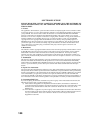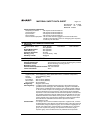
MATERIAL SAFETY DATA SHEET
Data Revised: Jul .31, 2002
Data Issued: Jun. 1, 1998
MSDS NO. F-30831
Page: 3/4
Personal Protective Equipment
Respiratory Protection :Not required under intended use.
Hand Protection :Not required under intended use.
Eye Protection :Not required under intended use.
Skin Protection :Not required under intended use.
Other Protective equipment :Use of a dust mask and goggles are recommended when
handling a large quantity of toner or during long term exposure,
as with any non-toxic dust.
9. PHYSICAL AND CHEMICAL PROPERTIES
Appearance
Physical State : Solid Form: Powder Color: Black Odor: odorless
Ph :Not applicable
Boiling/Melting Point :Not applicable
Flash Point (°C ) :Not applicable
Explosion Properties :No data
Density (g/cm
3
) :5.4 (bulk density : 2.09)
Solubility in water :Negligible
10. STABILITY AND REACTIVITY
Stability :Stable
Hazardous Reactions :Dust explosion, like most finely divided organic powders.
Conditions to avoid :Electric discharge, throwing into fire.
Materials to avoid :Oxidizing Materials
Hazardous Decomposition Products:CO, CO
2
and NO
X
Further Information :None
11. TOXICOLOGICAL INFORMATION
Acute Toxicity
Ingestion (oral) :LD
50
>2000mg/kg (Rats) (Estimated from the constituent components)
Dermal :LD
50
>2000mg/kg (Rats)
Inhalation :No data
Eye irritation :Not an irritant (Rabbits)
Skin irritation :Not an irritant (Rabbits)
Skin sensitizer :No sensitization
Mutagenicity :Negative (Ames Test)
Carcinogenicity :In 1996 the IARC reevaluated carbon black as a Group 2B carcinogen
(possible human carcinogen). This classification is given to chemicals for
which there is inadequate human evidence, but sufficient animal evidence
on which to base an opinion of carcinogenicity. The classification is based
upon the development of lung tumors in rats receiving chronic inhalation
exposures to free carbon black at levels that induce particle overload of the
lung. Studies performed in animal models other than rats did not show any
association between carbon black and lung tumors. Moreover, a two-year
cancer bioassay using a typical toner preparation containing carbon black
demonstrated no association between toner exposure and tumor
development in rats.
Chronic Effect :In a study in rats of chronic inhalation exposure to a typical toner, a mild to
moderate degree of lung fibrosis was observed in 92% of the rats in the high
concentration (16mg/m
3
) exposure group, and a minimal to mild degree of
fibrosis was noted in 22% of the animals in the middle (4mg/m
3
) exposure
group, but no pulmonary change was reported in the lowest (1mg/m
3
)
exposure group, the most relevant level to potential human exposures.


















